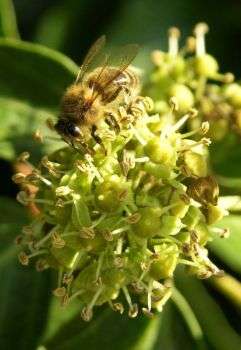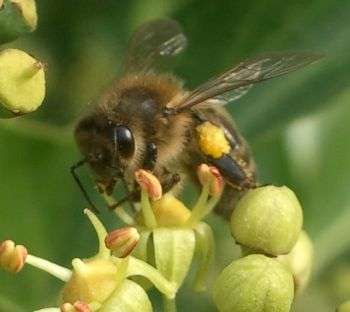The honey and the ivy: Why gardeners' foe is the bees' friend

Ivy, often maligned as a garden pest, is vital to honey bees and other pollinators seeking food in autumn, new research from the University of Sussex reveals.
The research, carried out by scientists at the University's Laboratory of Apiculture and Social Insects (LASI) is published online today (26 April 2013) in the journal Insect Conservation and Diversity.
It builds on LASI research into honey bee waggle dances and forms part of a wider project, 'Helping the honey bee and insect pollinators in urban areas', funded by The Body Shop Foundation.
Honey bees returning from successful forage trips perform the waggle dance to tell nest mates where to find nectar and pollen-rich flowers (the dance indicates the direction and distance to the flowers). Researchers video then decode the waggle dances and use the data to find out how far bees fly, where they go to and what types of plants they are feeding on at different times in the year.
The waggle dance data – collected from hives at the University, from nearby Falmer village and Brighton's Dorothy Stringer School – showed that, contrary to what might be expected, bee foraging distances decreased from summer to the autumn. As ivy blooms mainly in September and October, this suggested that the plant, which can be found growing both in towns and in the countryside, was having an important and beneficial effect on bee foraging, resulting in the bees having to fly shorter distances to find high-quality flowers.
Having access to high-quality supplies nectar and pollen late on in the flower season improves the chances of successful over-wintering for the hive.

For the ivy study, the researchers surveyed ivy flowers from rural and urban locations in September and October to count the honey bees and other insects foraging for nectar and pollen. They also identified the pollen brought back to hives by honey bee workers to determine the proportion from ivy and then surveyed ivy to determine how widespread it is.
In addition, the researchers measured the sugar concentration in nectar collected from ivy flowers by honey bee workers, and determined what proportion of honey bee foragers on ivy were collecting nectar versus pollen.
The main findings were:
- On average 89 per cent of pollen pellets brought by worker bees to hives were from ivy. There was no difference between hives located in an urban (Brighton) versus a rural area (University of Sussex).
- 80 per cent of honey bees foraging on ivy were collecting nectar not pollen.
- Ivy nectar was high quality, with a lot of sugar (49 per cent).
- Ivy flowers are visited by a wide range of insects, such as late-season butterflies, hover flies, other types of flies, wasps, bumble bees, and the ivy bee (a bee that specialises on ivy). Insects were attracted to ivy flowers in large numbers in both urban and rural areas.
- Ivy is common and available to insects in both town and countryside.
Professor Francis Ratnieks, who is Director of LASI and who co-authored the study, says: "Our research shows that ivy is hugely important to honey bees and other flower-visiting insects, such as late-season butterflies and hover flies, in the autumn. In fact, if ivy did not exist we would probably try to invent it.
"Most people don't even know that ivy has flowers. They are small and green with tiny petals. But the bees and other insects love them as they make lots of nectar and pollen."
Professor Ratnieks adds: "Ivy is often considered a pest and thus often removed due to the damage it is thought to cause to buildings and trees. In fact, ivy rarely harms the trees it climbs and has recently been appreciated for its benefits in providing extra insulation to buildings, as well as reducing pollution in urban areas. Our study provides further evidence of the benefits of ivy to wildlife, which we hope will be used to inform decisions of householders, land owners, and environment managers."
More information: Ratnieks, F. Ivy: an underappreciated key resource to flower visiting insects in autumn, is published in Insect Conservation & Diversity (March 2013).
Provided by University of Sussex





















